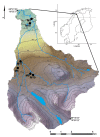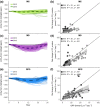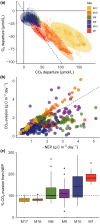Stream metabolism controls diel patterns and evasion of CO2 in Arctic streams
- PMID: 31667979
- PMCID: PMC7078971
- DOI: 10.1111/gcb.14895
Stream metabolism controls diel patterns and evasion of CO2 in Arctic streams
Abstract
Streams play an important role in the global carbon (C) cycle, accounting for a large portion of CO2 evaded from inland waters despite their small areal coverage. However, the relative importance of different terrestrial and aquatic processes driving CO2 production and evasion from streams remains poorly understood. In this study, we measured O2 and CO2 continuously in streams draining tundra-dominated catchments in northern Sweden, during the summers of 2015 and 2016. From this, we estimated daily metabolic rates and CO2 evasion simultaneously and thus provide insight into the role of stream metabolism as a driver of C dynamics in Arctic streams. Our results show that aquatic biological processes regulate CO2 concentrations and evasion at multiple timescales. Photosynthesis caused CO2 concentrations to decrease by as much as 900 ppm during the day, with the magnitude of this diel variation being strongest at the low-turbulence streams. Diel patterns in CO2 concentrations in turn influenced evasion, with up to 45% higher rates at night. Throughout the summer, CO2 evasion was sustained by aquatic ecosystem respiration, which was one order of magnitude higher than gross primary production. Furthermore, in most cases, the contribution of stream respiration exceeded CO2 evasion, suggesting that some stream reaches serve as net sources of CO2 , thus creating longitudinal heterogeneity in C production and loss within this stream network. Overall, our results provide the first link between stream metabolism and CO2 evasion in the Arctic and demonstrate that stream metabolic processes are key drivers of the transformation and fate of terrestrial organic matter exported from these landscapes.
Keywords: Arctic; CO2 evasion; carbon cycle; carbon processing; stream metabolism.
© 2019 The Authors. Global Change Biology published by John Wiley & Sons Ltd.
Conflict of interest statement
The authors declare no competing interests.
Figures






References
-
- Appling, A. P. , Hall, R. O. Jr. , Yackulic, C. B. , & Arroita, M. (2018). Overcoming equifinality: Leveraging long time series for stream metabolism estimation. Journal of Geophysical Research: Biogeosciences, 123(2), 624–645. 10.1002/2017JG004140 - DOI
-
- Aristegi, L. , Izagirre, O. , & Elosegi, A. (2009). Comparison of several methods to calculate reaeration in streams, and their effects on estimation of metabolism. Hydrobiologia, 635(1), 113–124. 10.1007/s10750-009-9904-8 - DOI
-
- Becher, M. , Olid, C. , & Klaminder, J. (2013). Buried soil organic inclusions in non‐sorted circles fields in northern Sweden: Age and paleoclimatic context. Journal of Geophysical Research: Biogeosciences, 118(1), 104–111. 10.1002/jgrg.20016 - DOI
-
- Blaszczak, J. R. , Delesantro, J. M. , Urban, D. L. , Doyle, M. W. , & Bernhardt, E. S. (2018). Scoured or suffocated: Urban stream ecosystems oscillate between hydrologic and dissolved oxygen extremes. Limnology and Oceanography, 64(3), 877–894. 10.1002/lno.11081 - DOI
Publication types
MeSH terms
Substances
Grants and funding
LinkOut - more resources
Full Text Sources

